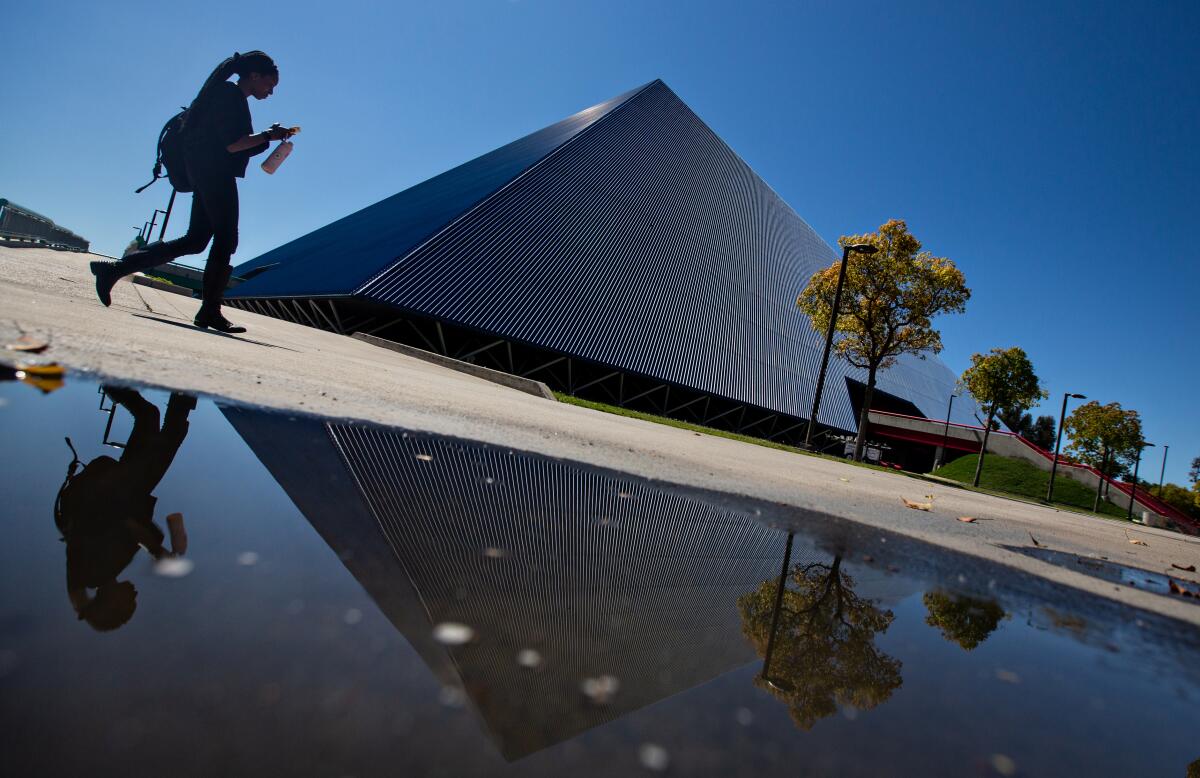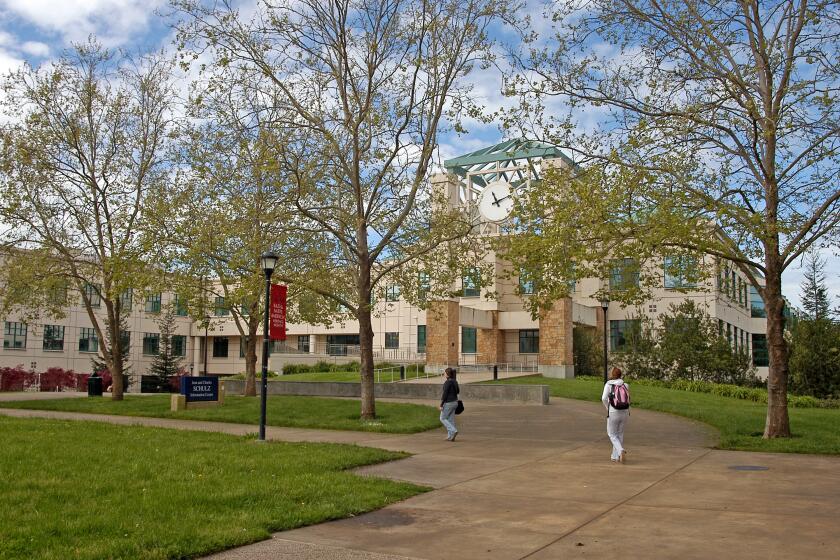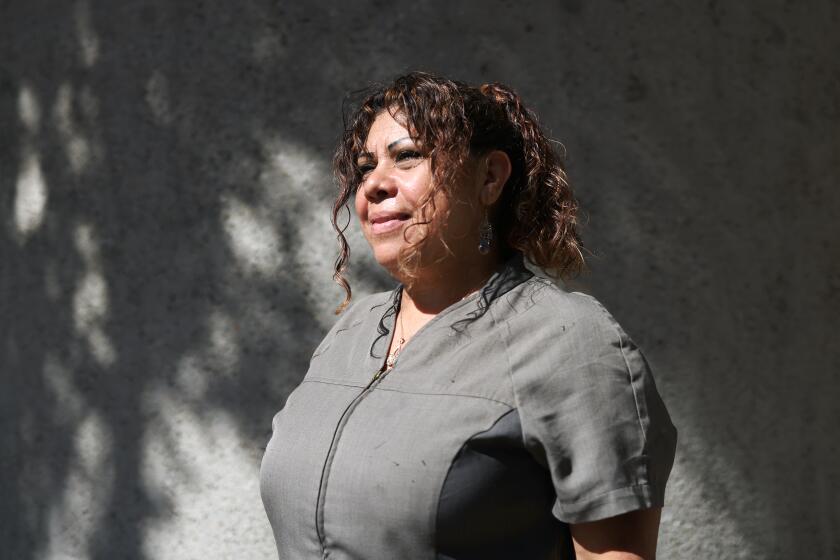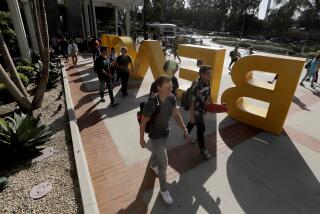Women, Black and Latino workers underpaid by California State University, study finds

- Share via
Women, Black and Latino workers are paid less than their white male counterparts at California State University, according to a union study.
Union officials say the disparities among nonfaculty members highlight a failing salary system that has not kept pace with the rest of the country.
CSU and labor leaders are working together to overhaul the salary structure to make the university more competitive on the job market.
The report compiled by the California State University Employees Union, which represents the employees, analyzed the salaries of nearly 12,000 nonfaculty workers at 23 campuses and in the chancellor’s office, including custodians, lab technicians and healthcare workers.
As a group, white women make about 5% less than white men, according to the study. Nonwhite men make about 3% less than white men and nonwhite women nearly 7% less.
The decision by President Judy Sakaki comes after a Times investigation detailed allegations of sexual harassment against her husband and retaliation by her.
The average salary for a white male nonfaculty CSU employee is $5,439 a month, compared with $4,762 for white women, $4,479 for Black women and $4,108 for Latino women, the study found.
Black men made an average of $4,446 a month — slightly less than Black women. Latino men made $4,205 a month.
On average, Asian employees made more than white employees — $5,165 a month for Asian women and $5,591 for Asian men.
The report was based in part on a state-funded study released in April by the human resources consulting firm Mercer, which recommended that CSU invest $287 million into overhauling its salary system. That initial investment would have to be supplemented by tens of millions of dollars each year to ensure that CSU remains competitive.
CSU spokesperson Toni Molle said that officials in the chancellor’s office have not reviewed the union’s findings. But she noted that CSU worked with union leadership to prepare the Mercer report, which evaluated a bigger pool of workers than the union report — more than 30,000 nonfaculty workers.
“Mercer found that the CSU has a strong interest in offering salaries which are competitive and in line with the market but that it has been unable to do so consistently over time due to budgetary constraints,” Molle said in a statement.
The Latin American diaspora in Los Angeles is serving U.S. and foreign dignitaries at the ninth Summit of the Americas. But some don’t even know what the summit is about. Others don’t think it’s relevant to their lives. Many wish they had more of a say.
The report showed that CSU does not follow a consistent process for promotions and raises, basing them on a manager’s discretion rather than seniority or experience, according to Catherine Hutchinson, a biology technician at Cal State Channel Islands and CSUEU president.
“The current CSU salary structure for pay increases are heavily dependent upon managers, who are only human, but they also have biases, and some of us have biases that we are not even aware of,” Hutchinson said.
Those biases affect salary decisions and hurt women of color like herself, she said.
Hutchinson said she has had to take a second job teaching at Cal State Channel Islands.
She knows she can make more money outside of higher education but remains at CSU after 20 years because she enjoys working with students and faculty, she said.
The ILWU, the union representing dockworkers across the West Coast, is at the bargaining table with the PMA, the group representing shipping companies. The current contract expires on July 1.
CSU and union leaders are pushing state legislators and Gov. Gavin Newsom for money to increase salaries and even out the pay disparities.
Jim Philliou, CSUEU’s executive director, said the proposed legislative budget includes $100 million for a salary study and $100 million for general salary increases. The union is advocating for the $287 million recommended by Mercer.
“I’m hopeful,” Hutchinson said. “We’ve seen a glimmer of hope with a partial funding.”
Some CSU workers are grappling with whether to stay in their jobs as they feel the squeeze of a salary that does not go far enough.
Carmen Magaña, lead custodian at Cal State San Marcos, used to go grocery shopping twice a week. Lately, she can afford to go only twice a month.
A UCLA grad whose college career overlapped with her mother’s researched the joint journey of mothers and daughters pursuing higher education.
The cost of gas and overall inflation, along with her stagnant salary, make it difficult for her to save any money, let alone think about paying for her 17-year-old daughter Ashley’s college education.
“I’m thinking about going back to working a second job in the night,” Magaña said.
Most of the janitorial workers at Cal State San Marcos are Latino and enjoy their jobs, she said.
But their pay has not kept up with rising costs.
“We work really hard,” Magaña said. “There’s a lot of women custodians who have two jobs. You can see their faces. They are so tired.”
More to Read
Sign up for Essential California
The most important California stories and recommendations in your inbox every morning.
You may occasionally receive promotional content from the Los Angeles Times.















